Matador Network's Blog, page 963
December 5, 2019
Air New Zealand testing edible cups

Nothing goes together like cookies and coffee, and now Air New Zealand is bringing them closer than ever before. The airline is introducing edible cups to its inflight beverage service and airport lounges, which will be both delicious and a sustainable alternative to plastic.
Created by Kiwi and family-owned business Twiice, the leakproof, vanilla-flavored biscotti cups are entirely edible — just wait until you finish your drink to dive in. Made from wheat flour, sugar, egg, and vanilla essence, they can also be used as dessert bowls.
Currently, Air New Zealand serves its coffee in plant-based compostable cups, but the airline plans to eliminate this system so that none of its cups go into landfills.
Last July, the airline committed to reducing its single-use items by removing individual plastic water bottles from its Business Premier and Premium Economy cabins, as well as from its Works Deluxe offering on Tasman and Pacific Island services under five hours in duration. Individual plastic sauce packets have also been entirely eliminated from its aircrafts.
Last week, Air New Zealand was voted best airline of 2020 by Airline Ratings.
Right now the cup is being tested at local Auckland airport lounges and on select routes, but if you’re not planning to fly Air New Zealand anytime soon, you can actually order them online for a taste. 

More like this:
The post Air New Zealand trials edible vanilla-flavored cups for its coffee appeared first on Matador Network.

France strike travel disruptions

Today, France is experiencing its largest nationwide strike in recent memory. Changes to the pension system promised by Emmanuel Macron during his presidential campaign are coming, and in anticipation of the overhaul, rail workers, air-traffic controllers, teachers, firefighters, police, and public sector staff are taking to the streets all over the country.
For visitors to the French capital, this is bad news; sites like the Eiffel Tower, Musée d’Orsay, and Versailles have been shut down for the day. Eleven of the 16 metro lines in Paris are closed, and only a third of the buses are circulating.
December 4, 2019
Miami LGBTQ travel guide

Glass skyscrapers rise from electric blue waters, neon-pink lights illuminate Art Deco masterpieces, and the parties only end once the South Florida sun rises over the Atlantic shoreline’s soft bed of white sand. This is Miami — a multicultural melting pot with a long history as a gaycation destination. Aside from must-see spots like glitzy-gay South Beach and artsy-fartsy Wynwood, Miami throws a gajillion LGBTQ events throughout the year where international crowds live out their best 1990s Will Smith fantasy and “party in the city where the heat is on.” Bienvenido a Miami.
LGBTQ history
The fight for LGBTQ equality in Miami has often mirrored the wild waves of hurricane season. Queer communities in the 1950s and 1960s found solace at bars and on beaches but were subject to frequent police raids and arrests. Five years after the city’s first LGBTQ pride-related activities in 1972, local anti-gay activist Anita Bryant’s national “Save Our Children” campaign smeared homosexuals as a danger to children. She swayed public opinion to vote against LGBTQ anti-discrimination laws. In 1980, The Mariel boatlift succeeded in bringing thousands of LGBTQ Cubans seeking asylum to the shores of Miami. Sadly, the coming AIDS epidemic would decimate their numbers along with the rest of Miami’s gay community.
In the late 1990s, things began looking up. Miami banned discrimination based on sexual identity in 1998. Gender identity discrimination finally followed in 2014. The city’s first sanctioned Pride parade happened in 2009. In 2015, Miami-Dade County became the first place in Florida to issue a same-sex marriage license.
The city’s most exciting queer history predates all these landmark moments by decades. It took place in 1937 at La Paloma, a nightclub in what is now Miami-Dade County. La Paloma, known for female impersonators, lude comedy acts, and striptease performances was one of the earliest LGBTQ outposts in South Florida. It was also a vulnerable target for anti-gay extremists. On November 15th, nearly 200 members of the KKK stormed the bar in white hoods. Everyone was forced to leave, and the owners were told to close up shop. In spite of subsequent threats and police raids, La Paloma reopened with a new skit with performers in white robes openly mocking the terrorist organization. This act of resistance is a shining example of Miami’s queer community. When faced with adversity, LGBTQ Miamians always knows how to bounce back and keep the party going.
Bars by neighborhood
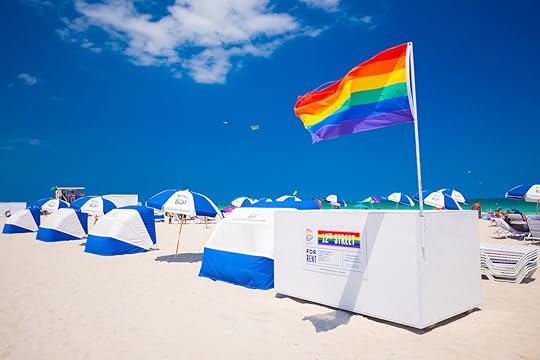
Photo: Mia2you/Shutterstock
South Beach
In the 1980s and 1990s, the queer community colonized the area between 10th and 15th Street from Ocean Drive to Washington Avenue. Although many LGBTQ clubs have shuttered in recent years, South Beach is still the place to stay and play if you’re looking for a gay old time. It’s also quintessential Miami. With expansive beaches, iconic Art Deco architecture, and clubs that blare music all night long, it’s no wonder South Beach is often the first and only stop for tourists who come to town.
Twist
With two levels, three dance floors, sevens bars, and zero cover, Twist is the Atlantis Cruise of gay clubs — once you hop on board, you don’t ever have to leave. It also holds the distinction of being Miami’s oldest queer club – undoubtedly a success because the club packs a little something for everyone. While the scene here doesn’t heat up until 1:00 AM, you can always find buff go-go boys working up a steam in the Gaiety Bar out back.
Where: 1057 Washington Ave, Miami Beach
Palace

Photo: Palace Bar/Facebook
All hail the royal queens of Ocean Drive! This South Beach staple is best known for its Friday-Sunday drag brunch, where you can drink your body weight in mimosas while watching drag performers do death drops from table tops for only $45. If brunch is still too ambitious after your all-night shenanigans, don’t worry — you can catch a Palace queen lip-syncing for her life every night of the week. Palace is conveniently located near Miami’s 12th Street Gay Beach — a great spot to soak up some midday booze before basking in the sun.
Where: 1052 Ocean Drive
WaterLOO
If you’re looking for something a little more chill where you can actually hear yourself talk, WaterLOO is your best bet — at least during the week. This new Miami hangout is known for its friendly service, reasonably priced drinks, and all-inclusive vibe.
Where: 1216 Washington Avenue
CLUB BOI @ District3
Club Boi is a South Beach dance club that attracts a mostly black and Latinx crowd. The music tends toward hip-hop, reggae, and Latin, which can be a welcome respite from the pop and house music you’ll hear blaring at most other South Beach bars.
Where: 3632 NW 25th Avenue
Hôtel Gaythering

Photo: Hôtel Gaythering/Facebook
The Hotel Gaythering is the Swiss Army Knife of gay establishments — it does everything you want it to and then some. It’s an industrial-chic boutique hotel that caters to a diverse mix of international guests. It’s a men’s sauna (yes, that kind of sauna). It’s a laid-back bar that hosts a series of themed nights (Wednesday’s trivia night actually makes trivia fun). The hotel is even home to Art Gaysel — a show featuring over 30 queer artists during Miami’s annual Art Basel. It’s also an easy 20-minute walk from the majority of LGBTQ nightlife between Ocean Drive and Washington Avenue.
Where: 1409 Lincoln Road
Wynwood

Photo: susana valera/Shutterstock
Wynwood is Miami’s capital of cool: Colorful murals cover streets lined with contemporary art galleries, boutique shops, trendy restaurants, and some of the city’s slickest bars. Although the outcropping of LGBTQ-specific nightlife here is limited, this walkable neighborhood is part of the Millennial ideology where all are welcome and included.
Gramps

Photo: Gramps/Facebook
This Wynwood watering hole is hipster-bait for people of all persuasions, but Thursday night’s Dubble Stubble, a dance party and drag show, is as queer as they come. Even if you don’t make it to this popular LGBTQ-flavored event, it’s worth checking out Gramps for the reasonably priced food and drink menu. The performance space hosts everything from stand-up comics to drag queen bingo throughout the week. Check the website for an up-to-date show schedule.
Where: 176 NW 24th Street
Wood Tavern
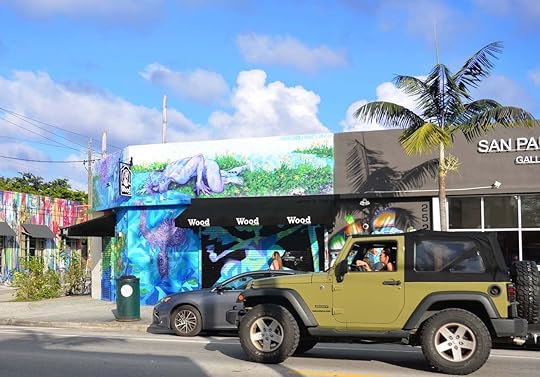
Photo: Wood Tavern
Located across from Wynwood Walls, Miami’s premier street art gallery, this indoor-outdoor bar attracts an artsy and eclectic crowd. Funky murals cover almost every inch of wall space in Wood Tavern, including pieces by graffiti gurus like Os Gemeos, Alexis Diaz, and How & Nosm. While it’s not explicitly LGBTQ-oriented, you’re bound to bump into a bunch of queer kids shaking their tail feathers underneath the night sky on the massive outdoor dance floor.
Where: 2531 NW 2nd Avenue
Coconut Grove and Little Haiti
Although South Beach is by far the biggest gayborhood in South Florida, if you’re hanging out in Coconut Grove, check out Azucar Nightclub and Club Aqua — the city’s only remaining gay bathhouse. Head north to Little Haiti for Jamboree Lounge, a gay neighborhood dive bar that serves wine and beer.
Wilton Manors and Fort Lauderdale
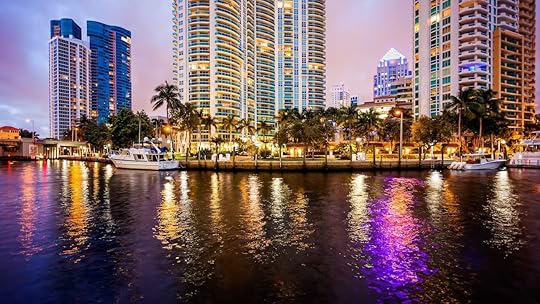
Photo: CrackerClips Stock Media/Shutterstock
It’s impossible to talk about Miami’s LGBTQ scene without mentioning that two of America’s most beloved queer destinations are less than an hour’s drive away. Wilton Manors, a 10-minute trip from downtown Fort Lauderdale, is the epicenter of this queer community. You can choose from a healthy helping of bars along Wilton Drive (The Manor and Hunter’s both draw big weekend crowds), queer-owned restaurants (head to Rosie’s for burgers or lesbian-owned Le Patio for French cuisine), and even gay coffee shops (check out Java Boys or Stork’s). Wilton Manors is also home to the Stonewall National Museum and Archives. Fort Lauderdale famously caters to a more mature LGBTQ community, and Sebastian Street Beach is the unofficial gay hang where these older bronzed beauties like to sunbathe.
Gay beaches
12th Street Beach
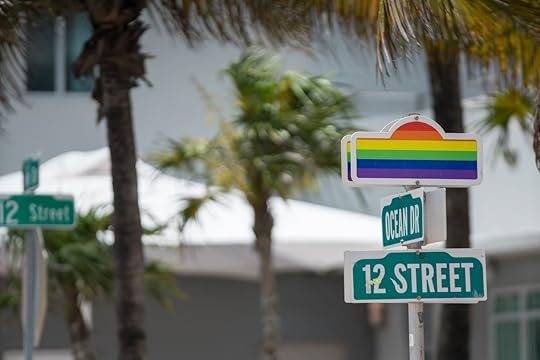
Photo: Felix Mizioznikov/Shutterstock
If your dream is to drown in a sea of teeny speedos, the gay beach at 12th Street is your fantasy come true. To get there, cross the street from Palace (South Beach’s biggest drag bar) and walk past the bike path that snakes through Lummus Park. You’ll know you’ve arrived once you spot the rainbow flags; you’ll know where to set up your beach towel once you spot the most appealing banana hammocks on display.
Where: 12th Street & Ocean Drive
Haulover Naturist Beach
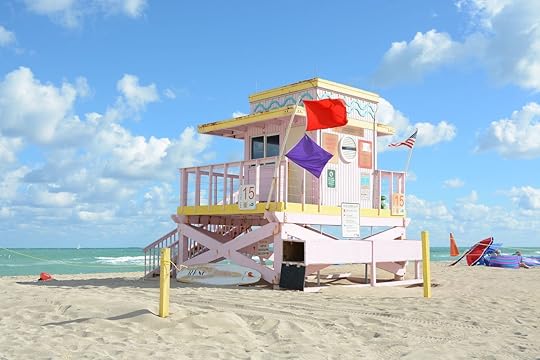
Photo: photravel_ru/Shutterstock
No shirt? No shoes? No problem. Nearly a third of Haulover Park Beach’s 1.5-mile expanse of creamy white-sand beach is devoted to naturists, making it the largest sanctioned nude beach in the United States. It’s egalitarian sunbathing at its best — both beach bums and business folk strip down to their birthday suits to soak up the Miami sun like lazy lizards. Don’t be surprised to see people of all ages, shapes, sizes, and sexes. Do remember to be respectful — while there’s a gay section (you’ll know it when you see it), this isn’t a place for hanky panky.
Where: 10800 Collins Avenue
Note: Haulover is a 30-minute drive from South Beach and less than an hour via public transportation (take the 120 to Collins Avenue & 15800).
Events
Wigwood

Photo: Wigwood/Facebook
Get out your lace fronts, ladies. Wigwood has been celebrating the gender-bending beauty of wigs and those who love to wear them in a weekend-long extravaganza since 2017. The festival, created by local drag celeb Queef Latina, hosts multiple parties throughout the city featuring queer artists, musicians, and some of the most boundary-breaking drag performers in America. Dress to impress! All the world’s a runway at Wigwood, and even the attendees come out of the closet to shine.
When: Early February
Sizzle
This five-day circuit festival caters mainly to gay men of melanin. Since its inception in 2002, it’s been serving up black boy joy to thousands from around the country who gather together every Memorial Day Weekend in a celebration of life, liberty, and the pursuit of dancing. There are pool parties during the day, raves that last late into the night, and at least one takeover of the naturist section at Haulover Beach. Check out the Sizzle Miami website to purchase event packages and find participating lodging.
When: May
Gay8 Festival (“Gay Ocho”)

Photo: Gay8 Festival/Facebook
Miami isn’t known as “the capital of Latin America” for nothing. With over 60,000 attendees, Little Havana’s February fiesta is the largest annual Hispanic LGBTQ event in the nation. Calle Ocho, Miami’s Southwest 8th Street, shuts down for the festivities to showcase the neighborhood’s unique blend of music, food, and art. Expect everything from wild dance parties in the street, free queer films at the Tower, live music, speeches from community activists, and booths showcasing South Florida’s most celebrated artists. There’s even a doggy obstacle course where locals can party with their pups.
When: Mid February
Aqua Girl
Every autumn, Miami Beach hosts the largest gay women’s charity event in the country. Unlike the boy-centric bashes that take place throughout the year, this female-focused fête caters primarily to lesbian, bi, trans, and nonbinary individuals. As the title suggests, Aqua Girl is all about getting wet. Saturday’s pool party is the main event, though there’s a large helping of parties where you can cut a rug throughout the week. A portion of Aqua Girl’s proceeds goes to The Aqua Foundation for Women, a local LGBTQ-focused nonprofit.
When: October
Winter Party

Photo: Winter Party Festival/Facebook
What began as a one-night-only beach party in the winter of 1994 is now a six-day music and dance festival attended by nearly 10,000 people from around the world. Miami Beach hosts over 20 events where you can step-touch until you drop all week long, but I wouldn’t suggest dropping until after the annual beach party at Lummus Park. Of the events, this is the shiniest jewel in the circuit queen crown. A portion of the proceeds go to the National LGBTQ task force, helping to support 80 nonprofit organizations in South Florida.
When: Early March
White Party
We’d be remiss to list Miami’s best annual LGBTQ events without mentioning the White Party, the world’s oldest HIV/AIDS dance fundraiser. The festival began in 1985 and attracted huge crowds, but 2018 may have been its last year. It’s not yet clear what the future holds, or if the White Party will ever return. For those looking for a similar experience, Winter Party is an analogous event.
Miami Beach Pride

Photo: Gregory Reed/Shutterstock
The first city-sanctioned Miami Beach Pride Parade didn’t make waves until 2009 with about 15,000 attendees. Since then, Pride has transformed into a week-long celebration that now welcomes over 140,000 spectators. Festivities begin the first week of April, starting in recent years with a memorial honoring the victims of Orlando’s Pulse nightclub massacre. During the event, entitled Pride Lights the Night, buildings throughout Miami-Dade County decorate with rainbow-colored lights in a sign of solidarity. Along with the many parties, drag competitions, and community mixers that take place during the week, be sure to check out the weekend-long Pride Festival in Lummus Park. With two stages featuring dozens of live performances, 125 vendor booths, and a bunch of family-friendly activities, this raucous daytime shindig is the weekend’s most popular. The celebrations culminate in Sunday’s Pride Parade along Ocean Drive. Expect dozens of spectacular floats, participants dressed in an array of fantastical costumes, and onlookers dancing down the sidewalks on their way to the beach.
When: April
Accommodations
The Standard

Photo: The Standard
This Belle Isle getaway is an idyllic place to detox from Miami’s manic party scene. The sleek, spacious rooms come equipped with private terraces and vintage soaking tubs. There’s also a full-service spa where you can relax in a Finnish sauna or Roman waterfall hot tub. When you’re ready to retox, the Lido Bar is a chill spot to grab a cocktail and play some ping pong; the Lazy Sunday Barbecue party at the outdoor infinity pool is a popular event open to the public. While this isn’t technically an LGBTQ hotel, its proximity to South Beach makes it close enough to join the fun and far enough away to escape it.
Where: 40 Island Avenue
Hôtel Gaythering
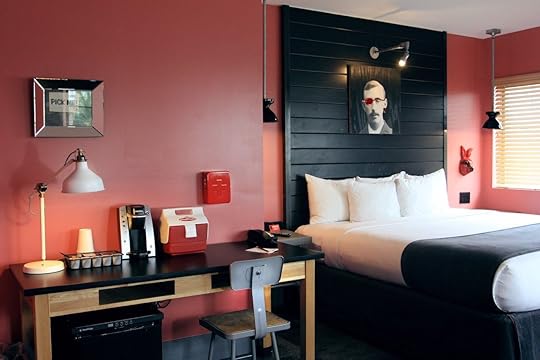
Photo: Hôtel Gaythering/Facebook
South Beach’s exclusively gay hotel is so queer-tastic it had to be listed here twice. The 1958 MiMo-style property has versatile room packages to fit all kinds of budgets. For size queens, try the swanky studios and comfy kings. For those looking to save, the no-frills private units with shared bathrooms are some of the most affordable accommodations in town. As noted before, Hôtel Gaythering offers all the amenities you need and attracts all the things you want while on vacation.
Where: 1409 Lincoln Road
The Villa Casa Casuarina (formerly the Versace Mansion)
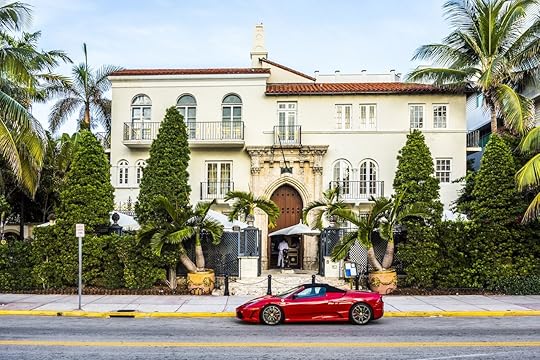
Photo: travelview/Shutterstock
It may seem creepy to walk over the threshold where Gianni Versace was shot to get to your room, but let’s be real — this storied beachfront palace, originally built in 1930 by rich-kid architect Alden Freeman, is fancy AF. If you’ve seen The Assassination of Gianni Versace, you know what I’m talking about.
Every room in this villa is dripping with baroque-style opulence. The soaring prices (over $700 a night) might make you think Ricky Martin will be waiting for you in a tight tennis uniform when you arrive, but don’t worry, you can still imagine all the butt stuff that went down in the mosaic pool (lined with 24-karat gold, no expense spared) when you take a dip. If you’re looking to be more a voyeur than an overnight guest, book a dinner reservation at the on-site Italian Mediterranean restaurant, Gianni’s.
Where: 1116 Ocean Drive
AxelBeach Miami
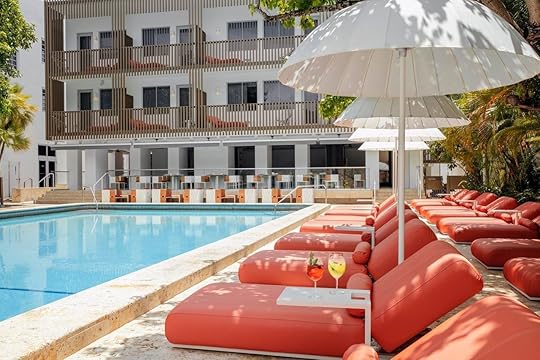
Photo: Axel Hotels/Facebook
When it finally opens, this “hetero-friendly” Art Deco hotel will be the second gay lodging option in South Beach and mere blocks from Miami’s 12th Street beach. Axel Hotels is a popular queer chain currently found in cities like Barcelona, Ibiza, and Berlin. The first available bookings for Miami begin in January 2020.
Where: 1500 Collins Avenue
MisterB&B
Airbnb, but make it gay. This home-sharing platform offers opportunities to live like a local by either staying with one or playing pretend while they’re away.
Where: Online
More information
LGBT Visitor Center on Miami Beach
The staff at the visitor center inside Old City Hall provides reliable, up-to-date information on the best things to do around town. Centrally located in South Beach’s gayborhood, it’s worth stopping by if only to ogle the beautiful Spanish Colonial Revival architecture from outside.
Where: 1130 Washington Avenue 

More like this: The 11 coolest Art Deco buildings in Miami
The post The ultimate LGBTQ guide to Miami appeared first on Matador Network.

The best easier hikes in Nepal

A figure in a snowsuit so puffy it conjures images of the Michelin Man trudges slowly through knee-deep snow. His frozen nose is black with frostbite, and with every breath, more ice crystals form on his massive, rugged beard. Suddenly, there’s a loud crack and a deafening rumble. Avalanche!
It’s scenes like this that come to mind when most of us imagine trekking in Nepal.
It’s no wonder given that Nepal is home to Mount Everest and seven more of the world’s tallest peaks. Yet only about 800 out of the over one million visitors who come to Nepal each year have their sights set on summiting Everest. In fact, despite tightening restrictions on climbing Everest, Nepal is experiencing a tourism boom. So where are all those visitors heading? Turns out, you don’t have to be an accomplished adventurer to enjoy Nepal.
“We like to say ‘Mountain is about attitude, not altitude,’” says Bimal Karki from Apex Himalaya, one of the top-rated trekking agencies in Kathmandu. His brother Bikram and their team of certified mountain guides have designed and led trips to fit a wide range of ages and abilities. “We have experience hiking in the mountains with kids as young as three years, on up to 68 years old, from healthy people to people who suffer from asthma. Nepal offers different grades of adventurous activities from beginner hikers to hardcore mountaineers, and from backpacker to lavish traveler.”
If epic mountain vistas, fresh dumplings, spiced tea, and vibrant culture sound up your alley — but months of intense physical training does not — consider these five adventures any moderately fit person can totally handle.
1. See Gosaikunda Lake and experience Tamang culture in Langtang National Park

Photo: PatKov/Shutterstock
Perfect for: beginner or intermediate hikers looking for the Nepalese trifecta: mountains, culture, and history
Difficulty: 6-7/10, depending on itinerary
Days Needed: six to 14, depending on itinerary
Elevation: average 8,021 feet, highest 14,370 feet
Highlights:
Hike through rhododendron fields and pine forests
Watch for grey langur monkeys, red pandas (also called red bear-cats), Himalayan thars (which look similar to mountain goats), and musk deer
Enjoy snow-capped views of Langtang Lirung mountain and the Ganesh Himal range
Stay in a homestay and experience local life and Tamang culture
Keep an eye out for the elusive red panda as this off-the-beaten-path hike takes you through pine forests and across iconic suspension bridges. You’ll experience Tamang culture up close and support local villagers with an overnight stay at Gre Village Community Homestay. (Gre village is a particularly good place to see the lingering impact and recovery from the devastating 2015 earthquake.) As the trek winds from village to village, you’ll pass several Bhuddist monasteries, sparkling white stupa monuments, a yak cheese factory, and many small stalls selling local handicrafts. The highlight of the trip is the pristine alpine lake Gosaikunda. The bright blue waters, which remain frozen six months of the year, are an important holy site, attracting thousands of pilgrims each year during two festivals.
2. Savor expansive mountain views in Panchase

Photo: Jose Coso Zamarreno/Shutterstock
Perfect for: seniors, luxury travelers, beginner hikers, or anyone wishing to dip a toe into adventure travel
Difficulty: 4/10
Days Needed: three to six, depending on the starting point
Elevation: average 2,690 feet, highest 8,200 feet
Highlights:
Watch the sunrise over the Himalayas
Hike through rhododendron fields and oak forests
Enjoy views of stunning, snow-capped Machapurchhre, Hiuchuli, Mt. Dhaulagiri, Mt. Manasalu, Gangapurna, and Annapurna
Visit the Gurung cultural heritage village of Sidame
Explore Pokhara lake and town
This totally doable hike packs a massive mountain-view bang for your physical-exertion buck. A few hours of hiking on a mix of flat paths, stone steps, and moderately sloping trails will pay off with panoramic views of some of Nepal’s highest and most famous mountains — including the Annapurna range, Manasalu, Dhaulagiri, and Gangapurna. You’ll start and end in the chilled-out lakeside town of Pokhara. It’s an ideal place to while away a few more days and rest your not-so-tired feet.
3. Escape from Kathmandu in Shivapuri National Park

Photo: Nepalifilmmaker/Shutterstock
Perfect for: tacking on some hiking to a short visit, stopover, or business trip to Kathmandu
Difficulty: 4/10
Days Needed: three to four
Elevation: minimum 4,400 feet, highest 8,950 feet
Highlights:
Watch for grey langur and red pandas
Hike through pine and oak forests
Cross the Sundarijal dam
Enjoy views of snow-capped Machapurchhre, Hiuchuli, Mt.Dhaulagiri, Mt. Manasalu, Annapurna, and Gangapurna
Visit the Tamang village of Mulkharka
Watch the sunrise over the Himalayas
Explore the historic temples, pottery, and artwork of Bhaktapur city and cultural site
It’s hard to believe that just 30 minutes from the dusty cacophony of Kathmandu’s lovable chaos there’s a place where the only sounds you’ll hear are birds chirping, a bubbling stream, and the occasional monkey hooting from the treetops. This trek through Shivapuri National Park has three solid days of hiking, but after one tough ascent the trail flattens out, and it’s mostly downhill from there. If the weather — or, more accurately, the smog from Kathmandu — cooperates, you’ll wake up each morning to panoramic mountain views.
4. Summit Kangin Ri and experience Tamang Culture in Langtang National Park

Photo: naturemania/Shutterstock
Perfect for: beginner or intermediate hikers up for an epic adventure or looking to bag their first summit
Difficulty: 7/10
Days Needed: nine to 10
Elevation: average 8,609 feet, highest 14,927 feet
Highlights:
Hike through rhododendron fields and pine forests
Watch for grey langur, red panda, Himalayan thar, and musk deer
Enjoy views of snow-capped Langtang Lirung and Ganesh Himal
Stay in a homestay and experience local life and Tamang culture
Summit Kyangjin Ri and get up-close panoramic views of snow-covered Langtang Lirung and several other peaks
You’ll start off on the same route as the first entry, gaining elevation through pine forests and rugged terrain that’s home to red pandas, grey langurs, Himalayan thars, and musk deer. Accommodations in a local homestay on the first night will provide a good base understanding for the Tamang culture you’ll experience throughout the trek. (Gre village is a particularly good place to see the lingering impact and recovery from the devastating 2015 earthquake.)
Langtang National Park is one of Nepal’s better-kept secrets, and it’s likely you’ll see more donkeys navigating the winding footpaths than fellow tourists. The literal pinnacle of your trek will be reaching the summit of Kyanjin Ri. From there, you’ll be mere feet from the imposing Langtang Lirung and have unobstructed, nearly 360-degree views of the stunning Himalayas. Find the plaque marking the elevation and take your token summit photo among a shrine of Tibetan prayer flags. Then hike down to replenish your energy supplies with fresh yak cheese or a yak-milk latte.
5. Savor Everest views near Lukla

Photo: saiko3p/Shutterstock
Perfect for: families or beginner hikers who want to experience the world’s most famous mountain without the snowy sufferfest
Difficulty: 6/10
Days Needed: 5.5
Elevation: average 10,300 feet, highest 11,286 feet
Highlights:
Hike through rhododendron fields and pine forests
Watch for grey langur, red panda, Himalayan thar, and musk deer
Enjoy views of several of the world’s highest, snow-capped peaks: Everest, Ama Dablam, Thamserku, Konge Peak, Nuptse, Lohtse, and Cholatse
This trek gets your adrenaline pumping from the very start, with a twin-engine plane ride into Lukla Airport, lovingly dubbed “the world’s most dangerous airport” thanks to its precarious location at the edge of a mountainside, 9,317 feet in the air. After a brief acclimatization stop in Lukla, you’ll hike along a river through pine and oak forests and across picturesque suspension bridges decked out in colorful Tibetian prayer flags. Reasonably short hikes each day will leave plenty of time to enjoy the dramatic views, appreciate the many brightly painted sacred Mani stone walls, explore the colorful village of Namche Bazar, sample local “Rakshi” wine, and learn about Sherpa culture at the Sherpa Museum. Though, again, perhaps the most unforgettable experience will be watching the sunrise over Everest. 

More like this: Things you need to know before climbing up to Everest Base Camp
The post 5 gorgeous Himalayan treks you don’t need to train for appeared first on Matador Network.

Different types of meditation

As meditation continues to become more and more popular in the West, many meditation and yoga studios have begun to offer unique meditation classes that push past the limitations of stereotypical meditation. If you tend to feel uncomfortable or awkward during traditional meditation, rejoice in knowing that other, more lively options exist. No more sitting silently, cross-legged on a pillow for 60 minutes — nope, these intriguing types of meditation will, quite literally, have you soaking in sound and rolling on the floor in laughter.
1. Foam rolling meditation

Photo: Iryna Inshyna/Shutterstock
This type of meditation encompasses a fitness and physical recovery aspect, unlike most other meditations that focus solely on mental and emotional health. During a foam rolling meditation, you combine self-myofascial release (SMR) and meditation to loosen up both body and brain, respectively.
SMR refers to the act of manipulating your own soft tissue, much like a massage therapist would during a massage. Benefits of foam rolling include easing the pain of sore muscles, improving flexibility and mobility, encouraging healthy blood flow, and more. Combine that with the benefits of meditation — reduced stress and anxiety, improved sleep quality, increased focus and alertness — and you’ve got a total brain and body recovery regimen.
Experience it: At Unplug Meditation Studio in Los Angeles, California, you can find unique foam rolling meditation classes that involve 45 minutes of SMR and mindfulness. If you can’t find a foam rolling meditation class near you, many yoga and fitness studios offer foam rolling sessions — just attend one of those and meditate on your own (you don’t have to tell anyone). Additionally, foam rolling meditation can be done in your home, outside, or anywhere you have enough physical space to foam roll and enough mental space to meditate.
2. Laughter meditation

Photo: mimagephotography/Shutterstock
This may be the simplest yet weirdest type of meditation on this list. Laughter meditation capitalizes on the health benefits of laughing, which include soothing tension, relieving stress, making you happier, and even stimulating your organs to function better. You may feel silly making yourself laugh, but it’s important to laugh often in a world where there’s much to be taken seriously. Laughter meditation can help you zero in on the good things in your life and cultivate a mindset of appreciation and gratefulness.
Experience it: If you feel nervous about making yourself laugh, you may want to try this at home first. You can try it alone or with a person you feel very comfortable with. Induce laughter by watching a funny video, telling yourself a joke, or recalling a hilarious memory. Let all your laughter out and, as the laughter subsides, fall into a joyous meditation. Allow any subsequent laughter to bubble up — don’t stifle it!
If you’re up for the challenge, try group Laughter Yoga at Charlotte Meditation Studio in Charlotte, North Carolina, or find a laughter meditation studio near you with Laughter Yoga University.
3. Brain massage meditation

Photo: wavebreakmedia/Shutterstock
Also called binaural beat meditation, this intriguing type of guided meditation attempts to help you reach deeper states of relaxation and focus than other types of guided meditation. Brain massage meditation involves gentle guided visualizations and utilizes technology to enhance the experience.
Binaural beats are considered “auditory illusions.” When listening to a binaural beat, you’ll hear two tones at slightly different frequencies (no more than a 30 Hertz difference), but your brain will process the difference between the two. For instance, if the two tones are 121 Hz and 110 Hz, your brain will process the sound at 11 Hz. These beats have been linked to relaxation, deep sleep, focus, and creativity.
Experience it: In my search for strange types of meditation, I found just one place to experience brain massage in a group setting: Unplug Meditation in Los Angeles. However, you can try brain massage on your own with a digital guided meditation.
4. Crystals and chakras meditation

Photo: Holly Mazour/Shutterstock
Okay, so crystal and chakras meditations have become so commonplace that you may not think they fall into the realm of “strange” types of meditation. But for beginners, crystals and chakras sure can sound like a lot of woo-woo information. The seven chakras are the energy centers of the body, and when clogged, they may prevent you from functioning optimally (think bad moods, poor sleep, cravings, lethargy, etc.). You can use crystals to unblock your chakras by placing the appropriate crystal on the blocked chakra and meditating.
Experience it: Most meditation studios and many yoga studios around the world offer crystal and chakra classes. If you have your own crystals and know a bit about the chakras, you can perform this type of meditation anywhere. Doing a crystal and chakra meditation outdoors, especially in a lush and quiet environment, can offer double the benefits, as connecting with nature is proven to improve mood and health.
5. Sound bathing meditation

Photo: Microgen/Shutterstock
Sound bathing is an ancient wellness practice that is experiencing a surge in popularity. This sound-healing practice is proven to reduce stress and anxiety, as well as promote restfulness. During a sound bath, you’ll meditate to various sounds, from Tibetan singing bowls to gongs to didgeridoos. The relaxing frequencies of these tools guide you into a deep meditative state that almost feels like you’re emerged in the sound, similar to being emerged in bathwater.
Experience it: Like crystals and chakras, sound bathing has become a common practice in the world of mindfulness and meditation. Almost anywhere you go, you can find a meditation or yoga studio that offers sound bathing. Some studios, however, are dedicated solely to the therapeutic effects of sound bathing. One such place is the Center for Sound Therapy in Boardman, Ohio. Harmonia Wellness Center in Sausalito, California, offers sound bathing sessions with a didgeridoo. And the above mentioned Unplug Meditation in Los Angeles and Recharj in Washington, DC, are other studios known for their sound bath classes. 

More like this: 9 workouts you can do on literally any vacation
The post 5 cool types of meditation and how to experience them appeared first on Matador Network.

Pubs are best way to discover Europe

This is the Travel Take, where Matador’s writers and editors make the case for their favorite travel hacks, tips, and personal tics.
Locals typically know a city’s bar scene best. Sometimes, however, you don’t have the luxury or time to consult the locals when you’re in a new city. Instead, you’re left searching Google, which can lead to cocktail bars with the same design and menu as the ones back home and spots filled with other tourists who made the same search query.
If you really want to get to know a new city, look for the pubs. Pubs are a window into the culture that hyped bars often can’t be. The unpretentious atmosphere, relaxed vibe, and under-the-radar status make a local pub the perfect place to feel right at home and meet people who actually call the neighborhood home. This is especially true in Europe, where you can find no-frills pubs in nearly every city, town, and village. These pubs are the ideal lens through which to view a new city for many reasons, but these are the top three.
The rules don’t apply
Okay, of course some rules apply, but the reason people love pubs is that they aren’t pretentious. No dress code, no cover charge, no bathroom attendant trying to spray you with cologne while you’re washing your hands. Getting dressed up once in a while is nice. Standing in a two-hour line at 1 OAK before walking down the checkered walkway into a world of faux-luxury is not exactly the best way to immerse yourself in a new place, though.
Many bars and clubs, especially high-end ones, come with a set of rules for everything. This includes, but is not limited to, how you dress, order, wait to enter, and how you act once you’re inside. It’s not like you can smash your beer glasses, start a 16-person brawl, or play Russian roulette in a pub, but since the atmosphere, staff, and clientele tend to be more relaxed, people are more likely to be at ease. This makes you more comfortable in a new bar in a new city and makes meeting people easier.

Photo: Wayne’s Bar/Facebook
Pretending to be James Bond at a fancy cocktail bar is fun and all, but it simply doesn’t compare to the communal debauchery you can partake in at a pub. I was a bit skeptical of spending my Friday night in Nice, France, at an Irish pub called Wayne’s, but it soon became clear to me that this — not the chic, outdoor cafes with heat lamps — was the place to be. At around 11:00 PM, everyone leapt on top of the long wooden tables with total disregard for the plates and glasses sitting there and danced like it was the last night of Oktoberfest. That kind of thing just doesn’t happen at trendy cocktail joints.
Because they’re NOT on top 10 lists
Every city has its own aesthetic, and pubs are usually a good microcosm of that aesthetic. Stripped of the gimmicks and flashy decor, pubs represent a city’s nightlife without obstruction. The best way to actually feel like you’re immersed in a place (and not just a tourist patronizing a bar designed for Instagram) is by posting up at a little pub that’s hidden away on a side road.
Before landing in Venice on a recent trip, I was given tons of recommendations for restaurants, cafes, and clubs that were supposed to be among the best in the city. But my favorite Venice venue was a little divey pub with five barstools, a jukebox, karaoke, and a dance floor barely big enough for six people. I’m not even sure what the place’s name is, though the neon sign glowing above the tilted doorway read “Sigarette.” When I went, it was supposed to be a “one drink, then move on” scenario, but once I realized the place offered the best people-watching in Venice, one of those five barstools became my home for the night. I listened to a woman do her best (or, more accurately, worst) Pavarotti impression, celebrated Venezia FC’s victory over Pisa with some avid soccer fans, narrowly avoided the advances of a pair of swingers, and I’m pretty sure I witnessed a drug deal two stools away. The next night I paid $12 a pop for Martinis while “Don’t Stop Believin’” blared in my ears, but when I think of Venice, I don’t remember Journey (thank God) — I remember Sigarette.
It’s where people hang out to get away from tourists
You’ll quickly find that, especially in big cities, locals tend to flock to bars you might not expect. Bars that aren’t necessarily the most trendy or popular on TripAdvisor, because those are the places quickly overrun by tourists. But as Groucho Marx once said, “I wouldn’t want to belong to a club that would have me as a member.” This pretty much explains the dilemma of tourists looking for an “authentic” nightlife experience abroad. Even if you do get lucky and find the bar where the locals hang out, by virtue of your presence you’ve made the bar inherently less local.
But as long as you’re respectful and don’t act like the other tourists you’re looking to avoid, this can be okay. Acknowledge the reality that you are a tourist, not one of the cool locals, and do your best to blend in. That way, you’ll get away from the crowds without being “that guy” ruining it for the rest. And you’ll have a better chance of being welcomed into the fold.

Photo: Ryan’s Pub/Facebook
Determined to have a “local” experience in Malta — an island known for its abundance of British vacationers looking to party — I wandered into Ryan’s Pub on the outskirts of the popular Paceville area. Set apart from the bustling St. George’s Road with its bars, nightclubs, and strip clubs, Ryan’s is a small Irish bar that looked relatively quiet from the outside when I passed by. The inside, however, was like a secret society meeting of Maltese 20-somethings, a veritable Cheers bar where everyone seemed to know everyone. Except me, of course. After overcoming the initial confusion that an American had wandered into this nondescript pub, everyone was incredibly welcoming and eager to introduce me to Maltese snacks and, of course, the traditional drinks.
A pub isn’t the only place you can find these local experiences, but it’s certainly among the best. 

More like this: The 11 best dive bars in Manhattan
The post Forget cocktail bars, pubs are the absolute best way to discover Europe appeared first on Matador Network.

Water sports you can do in winter

For some, water sports are a way of life. We’ve all heard stories of surfers who yo-yo between the northern and southern hemispheres year-round, chasing waves and dodging the inevitable winter withdrawal. Not everyone can uproot their lives every few months, though. Luckily for the rest of us there are winter water sports. With a little ingenuity, a number of the world’s favorite water sports have been adapted for the ice and snow, guaranteeing a good time for fans of both surf and slopes. From sailing across frozen surfaces to plunging below freezing waters, these seven winter sports will give you a new perspective on the summer pastimes you just can’t quit.
1. Iceboating

Photo: ericlefrancais/Shutterstock
If the phrase “World Cup” makes you think sailing regatta, not soccer match, iceboating is the winter water sport for you. Iceboats work much like sailboats though their sails are attached to narrow hulls that glide on three thin blades called runners. Before they were used for sport, iceboats were used as transport vessels as far back as 2000 BC in northern Europe. Their recreational potential was seized in 1865 when the Poughkeepsie Ice Yacht Club was established, followed by the Hudson River Ice Yacht Club and others. Nearly a century later, the International Ice Yacht Racing Association was incorporated in Michigan in 1962.
Today, ice yachting has a dedicated fanbase, with both national and international races held yearly. If you’re in the northern United States or southern Canada, particularly around the Great Lakes region, and want to try iceboating for yourself, track down the nearest club and ask about lessons, equipment, and the best places to go sailing in your area.
2. Ice diving

Photo: RLS Photo/Shutterstock
Scuba diving may conjure images of coral reefs, but not all divers surround themselves with sea turtles and tropical fish. Sometimes, the thrill comes from swimming below a frozen-over surface. Ice diving is extreme not only because of the water temperature, which requires divers to upgrade their wetsuits to drysuits, but also because there’s typically a single entry and exit point in the ice. As such, divers are tethered, and the exercise is considered a team sport. To enroll in the PADI Ice Diver course, you should already have an Advanced Open Water license and be 18 or older. Once you’re trained and certified, you can pursue ice diving everywhere from Alaska and New York to Russia, Greenland, and Antarctica.
3. Snowkiting

Photo: Parilov/Shutterstock
Much as snowboarding is compared to surfing on snow, snowkiting is what happens when you take kiteboarding to the slopes. Kiteboarders can use the same kite rig for both sports, swapping out their kiteboards for either downhill skis or snowboards come winter. Unlike traditional skiing and snowboarding, however, snowkiting is even possible on the flats as the lift from the kite propels you. The aerodynamic accessory also makes it easier to get enough air to pull off crazy jumps and tricks. Snowkiting is growing in popularity in snowsport destinations like Switzerland, Austria, and Norway. In North America, there are excellent options in or around many major winter resorts, from Jackson Hole in Wyoming to Banff in Canada.
4. Ice surfing

Photo: simonovstas/Shutterstock
No need to get jealous, windsurfers. Ice surfing combines sailing and boardsports just like windsurfing, only ice surfers glide across frozen surfaces on long, narrow boards attached to razor-thin blades, similar to the way iceboats operate. Lakes are ideal for ice surfing on a windy winter day so long as the ice is thick enough to surf on. If you’re sold on the idea, Canyon Ferry Reservoir in Helena, Montana, and Lake Winnipesaukee in Wolfeboro, New Hampshire, are two of the top ice-surfing spots in the US. The latter has even hosted international competitions.
5. Ice swimming

Photo: Levranii/Shutterstock
Tons of people swim during winter, whether they hit up the indoor pool at their local recreation center or sign up for polar bear plunges throughout the season. Ice swimming is more intense than the average cold-water dip, however. To start, it’s defined as swimming in 41 degrees Fahrenheit or colder water, whether a pool or natural water body, which often means accompanying sub-zero air temperatures. Per the International Ice Swimming Association (IISA), ice swimmers may only wear a standard swimsuit, a pair of goggles, and a cap.
Though there are health benefits associated with swimming in cold water, such extreme conditions are dangerous and should be worked up to slowly. Once you’re acclimatized, consider challenging yourself to the Ice Mile, a mile-long, supervised swim that you can do for fun or appeal to the IISA to ratify if you want your achievements officially recognized. Dozens of countries have their very own IISA outfits, making ice swimming one of the best winter sports for travelers, whether you’re interested in attending a race or getting in the water yourself.
6. Ice fishing

Photo: Fuss Sergey/Shutterstock
Early ice fishing practices trace back to North America’s indigenous inhabitants, who relied on spearfishing for sustenance even in winter. Today’s cold-weather anglers use technology like GPS and sonar to catch fish, as well as creature comforts like portable heaters to make their ice shanties, or huts, cozier. Ice fishing involves creating a hole in a frozen surface with an ice auger, dropping a line with a lighter-than-normal rod, and waiting for the fish to bite. It’s a particularly popular winter pastime in the Midwest, with ice fishermen taking to lakes throughout Michigan, Wisconsin, Illinois, Indiana, and more. The Great Lakes, particularly Lake Michigan, are among the best-established spots for ice fishing. Outside the US, ice fishing is also popular in cold-weather locales like Russia, Canada, and northern Europe.
7. Snow kayaking

Photo: Monarch Mountain/Facebook
If you’re dreading unearthing that sled that’s been collecting dust in your garage this winter, but love the thrill of a downhill dash, consider keeping your kayak handy year-round instead — if you have one. Snow kayaking is as wacky as it sounds, but Red Bull put it on the map when it hosted competitions on customized downhill tracks in Estonia and Lithuania a few years back. It’s still not the most established winter sport, especially as it’s classified as an extreme sport, yet select US ski resorts, including Colorado’s Monarch Mountain, do allow snow kayaking. 

More like this: The best places to go cold-water surfing this winter
The post 7 water sports you can still do when the temperature drops below freezing appeared first on Matador Network.

The largest pyramid in the world

When it comes to pyramids, Egypt hogs the limelight. But the towering, triangle-shaped edifices are not solely found in the pharaohs’ old stomping grounds — Sudan, Guatemala, and Iraq all have grand pyramids worthy of travelers’ attention. In fact, the largest of them all is in Cholula, Mexico.
The Great Pyramid of Cholula, also known as Tlachihualtepetl, is 177 feet tall and its base covers 45 acres — making it the largest monument ever constructed by any civilization on the planet. The enormous structure is located in a small town, just 80 miles from Mexico City, so it’s an easy day trip from the capital. Here is everything you need to know about the largest pyramid in the world and how to visit it.
The hidden pyramid

Photo: Gianfranco Vivi/Shutterstock
There’s a reason why the Great Pyramid of Cholula is not widely known: It is partially covered in dirt and topped with a Spanish colonial church. If you don’t pay attention, it looks like a large hill.
Legend has it that the Aztecs, when learning about the Spaniards advancing toward their city in 1519, worked day and night to cover the remains of the abandoned pyramid with dirt, to protect it from getting destroyed. Although built long before their time, the Aztecs still considered the edifice sacred.
The stratagem worked and no one suspected the existence of the pyramid until the end of the 19th century. When the soil used to disguise it as a simple hill started to erode, archaeologists recognized that there was a structure underneath. But there was no digging it up — in the late 16th century, the Spaniards had built the Iglesia de Nuestra Señora de los Remedios (the Church of Our Lady of Remedies) atop the fake mound of dirt and the church was a holy site protected by the state.
So, the experts found a way around the Catholic house of worship and dug about five miles of tunnels under it, through the hill, to explore, date, and understand the structure that had been hidden for so long.
How did this pyramid get to its size? Who built it?

Photo: doleesi/Shutterstock
The Great Pyramid of Cholula was built over hundreds of years, starting in 200 BC until the 9th century AD. Several ancient peoples of Mesoamerica, the Olmec and Toltec among them, built it in six phases during this time. They each added a new layer to the existing pyramid.
But, for reasons that remain unknown to this day, the people who used to populate this geographical zone all moved on, and by the time the Aztecs arrived in the area, around the 1300s, they found the structure abandoned. With no idea where it came from or who built it, they credited one of the seven giants from their creation mythology, Xelhua, with building the pyramid.
Visiting the pyramid and the archaeological site

Photo: aindigo/Shutterstock
About half a mile of the excavated tunnels have been transformed into a well-lit, arched passageway that is open to the public. Though you’ll find no signs to explain the structure, walking the underground maze helps get an understanding of the immense size of the pyramid. On either side of the main tunnel, niches showcase ancient artifacts, like clay figurines, found during the excavations.
The tunnels start on the north side of the pyramid, cut through its center and emerge on the south side, at the entrance of a large archaeological site.
Although the main entrance takes visitors through the tunnel, a pathway leads around the structure directly to the archaeological site for those who don’t wish to go underground.

Photo: Noradoa/Shutterstock
The first stop is the Southeast Plaza, where visitors can observe a few excavated elements, some of them showing the different phases of construction. One of the highlights of the plaza is a long mural, representing geometric figures in red and ochre, protected by a sheet metal roof.
Following the footpath along this area, visitors reach the Courtyard of the Altars, a complex of buildings that once marked the main entrance to the pyramid. This structure is a large open area bordered on the north side by the hill/pyramid. On the east and west, it is comprised of two raised platforms, the Southwest Plaza and the Patio of the Altars. The Patio of the Altars is surrounded by four altars. The second altar displays two feathered serpents, representations of the Aztec god Quetzalcoatl, carved along its base.

Photo: Diego Grandi/Shutterstock
Farther along the footpath, visitors can climb a small tiered pyramid. From the top, while you’re still way below the top of Quetzalcoatl, you’ll see a large part of the modern town of Cholula. Recently reconstructed, this small pyramid was one of the newer layers of the main structure, dating from around 500 to 700 AD.
Continuing on the trail around the site, visitors will reach the modern gate and stairway leading to the top of the pyramid.
Topped by a church

Photo: Cristobal Garciaferro/Shutterstock
The Spanish built the Iglesia de Nuestra Señora de Los Remedios on the highest point in the city, ignorant to the fact that the largest pyramid in the world lay beneath the soil. The church dominates its surroundings — the active volcano Popocatépetl is its only rival in the landscape.
Mass is still held in this ornate Catholic church every Sunday. Those visiting the pyramid on a Sunday can hear the music and mass all the way on the bottom of the hill/pyramid.
On a clear day, the views from the courtyard surrounding the church are spectacular. Visitors can not only see the entire town of Cholula, but also the surrounding volcanoes, Popocatépetl, Iztaccíhuatl, and La Malinche.
How to get there
Though little known, the Great Pyramid of Cholula, in the state of Puebla, is easy to reach. Fly into Puebla City and then take a taxi to San Andrés Cholula. (You need to mention San Andrés, since there are two different towns named Cholula.) If you’d rather use public transportation, there are local buses between Puebla and Cholula.
Estrella Roja has a bus service from Mexico City’s TAPO bus station to Plaza San Diego in San Andrés Cholula. The bus stops close to the pyramid; you’ll see the ticket booth and entrance as soon as you get off.
There is an entrance fee for the archaeological site, which includes the walk through the tunnel. Entrance is free on Sundays.

Photo: Gianfranco Vivi/Shutterstock
You can also climb the pyramid for free without visiting the archaeological site. A different entrance, always open, leads via a paved pathway to the top. Though a gate to the church grounds is locked overnight, you can walk up to the top of the hill/pyramid and get a feel for its size and have a great view of Cholula below. 

More like this: 11 African ruins you need to see besides the Pyramids
The post The largest pyramid in the world isn’t in Egypt. It’s in Mexico. appeared first on Matador Network.

Blockbuster pop-up in NYC

You might feel too young to be starting your ‘90s stories with “back in my day…” but for many, the 1990s feel like a lifetime ago. This is especially true if you were a regular Blockbuster customer, spending an hour examining the VHS boxes with your parents before deciding which one you’d bring home, or trying to sneak into the X-rated section while your mom was deciding between renting Almost Famous and Mona Lisa Smile for the third time that month. Now, for a brief time, you can actually relive those sacred moments inside the video store with this pop-up Blockbuster experience coming to Soho.
Dumbgood, an apparel brand, has partnered with Blockbuster to offer a pop-up shop selling Blockbuster-themed merchandise, including vibrant yellow-and-blue backpacks, sweatpants, hoodies, T-shirts, VHS iPhone cases, coffee mugs, tote bags, 14-karat gold necklaces, and more nostalgia-laden items.

Photo: Dumbgood x Blockbuster
Located at 13 Crosby Street, the store will closely resemble the interior of the Blockbuster you knew and loved, and will be open from December 6 to 15.
If you can’t make it to New York City for the event, note that there is one Blockbuster left standing in the US and it’s located in a strip mall in Bend, Oregon. It’s open daily from 10:30 AM to 9:00 PM, and until 10:00 PM on Fridays and Saturdays, for all your VHS and DVDs needs. 

More like this: Why themed pop-ups are taking over bars and hotel rooms
The post Rewind time at this New York City Blockbuster pop-up appeared first on Matador Network.

2009 to 2019 was the hottest decade

As this year and decade come to a close, the World Meteorological Organization (WMO) paused and considered some inconvenient truths. Namely, that it has been the hottest decade on record, and that 2019’s experienced the second- or third-highest temperatures ever recorded.
According to the WMO’s report, not only have temperatures for the past 10 years been higher than any prior decade, but the concentration of greenhouse gas in the atmosphere has continued to rise in 2019 from the eye-watering level of 407.8 parts per million in 2018.
As a consequence:
The ice sheets have melted faster, leading to a rise in sea level.
The oceans being warmer and more acidic is destroying marine ecosystems and endangering wildlife.
Extreme natural events such as floods, wildfires, heatwaves, droughts, and tropical cyclones are becoming more intense and more common.
Population displacement and health risks are heightened.
Food security is deteriorating due to erratic weather events.
WMO Secretary-General Petteri Taalas explained, “If we do not take urgent climate action now, then we are heading for a temperature increase of more than 3°C by the end of the century, with ever more harmful impacts on human well-being.” The target of the 2015 Paris Agreement was to keep the temperature increase since the start of the industrial era well under 2 degrees Celsius. 

More like this: These 5 major cities are sinking rapidly into the sea
The post World Meteorological Organization knows best: This decade was the hottest ever recorded appeared first on Matador Network.

Matador Network's Blog
- Matador Network's profile
- 6 followers



